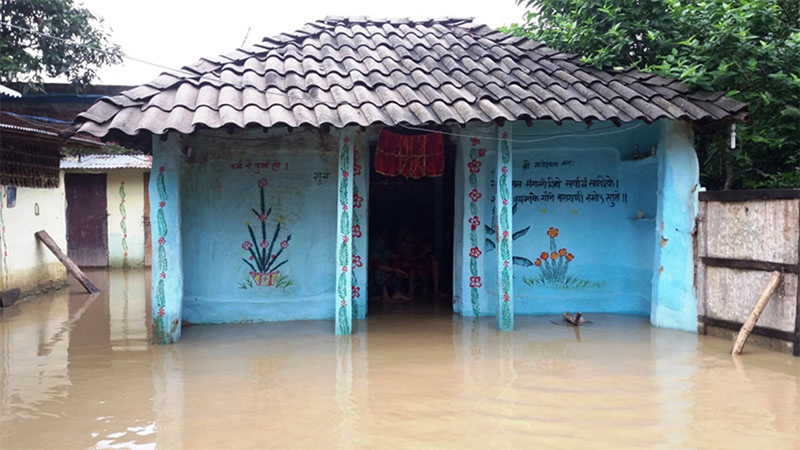
OR
Expert's view
Flood disaster: Focus on outbreak control !
Published On: August 14, 2017 04:30 AM NPT By: Sameer M Dixit

KATHMANDU, August 13: Nepal is not new to flooding and other natural disasters that are brought about by annual monsoon. In fact, if we go down historical records there are instances of flooding almost every year in the tarai, and also mudslides and avalanches in the hills/mountains areas. As long as the climatic conditions do not deviate significantly from the current norms, this phenomenon will continue in the years to come. In fact, with increasing urbanization and encroachment into natural resources, such events will only increase in Nepal.
One of the biggest challenges during, and post flooding situations is possible outbreaks of diseases in the affected community. There are diseases that can be transmitted between people, otherwise known as communicable or infectious diseases. Then there are diseases that would be inherent to a person, brought about by adverse conditions, also known as non-communicable diseases. In a natural disaster involving water, in case of flooding, communicable diseases are almost certain to occur.
There are viruses, bacteria and other organisms that can cause diseases, and many of these can thrive very well in water. One of the most common but controllable disease outbreaks is diarrheal disease outbreaks. These can be different types such as cholera, typhoid, dysentery among others and many affect the gut. Those are found in contaminated water mainly as a result of mixture with sewage, animal feces, and carcass. Others, which can be more dangerous are hepatitis A and hepatitis E, both of which are caused by hepatitis viruses capable of ultimately affecting the liver leading to complications and even death. There are also some other types of infectious agents that can cause other complications. All of these can also be controlled by various methods. These include adding chlorine tables to drinking water, boiling water used for consumption, washing hands with soap and clean water regularly, using gel-based hand sanitizers as immediate steps to prevent water borne disease outbreak. Long-term solutions include vaccination against many of the water borne diseases and also good sanitation and hygiene practices in the at-risk community.
The other type of health risk posed by natural disasters such as flooding is known as 'vector-borne' disease whereby an insect will carry the infectious organisms. This is especially true in hot and humid conditions where water reservoir is present. Tarai plains are perfect habitats for mosquitos and other insects that can carry organisms that cause malaria and dengue among other diseases. In the immediate aftermath of a flooding, the human population is usually without proper shelter and thus open to insect bites, leading to possible outbreaks of the diseases. The immediate solutions include proper clothing, mosquito nets, repellent use, and fumigation whenever possible. Children are especially vulnerable to such infections and therefore should be provided extra preventive measures. Furthermore, the risk of pneumonia, especially in children, and certain heart conditions in the older population is very much a possibility in flood disaster situations. Therefore shelter and dry warm clothing with proper nutrition would be required in the affected population.
To summarize, disease outbreaks in flood-affected areas of Nepal can be expected in the near future. However, this doesn't mean that the state cannot minimize the risks that contribute toward such events and control those before they become an epidemic. The most important step is the immediate one. Assessment of risks and strategies to mitigate those should be put into place by the Ministry of Health right away, in coordination with other ministries, line agencies (including non-governmental organizations) and experts. Sooner this takes place, the more likely that maximum number of suffering population will benefit from those actions.
Dixit (@smadixit) is the director of research at CMDN and general secretary of NPHF.
You May Like This

35 wards in Dang reeling under higher risks of flood
DANG, Aug 21: Dang district does not so far have any menace from the landslide. But, it is facing higher... Read More...

FLOOD ALERT: Chure, Mahabharat range likely to experience flood and landslides
KATHMANDU, July 1: Through a notice, the Department of Hydrology and Meteorology has issued an early warning notice urging residents... Read More...





Just In
- Unified Socialist leader Sodari appointed Sudurpaschim CM
- One Nepali dies in UAE flood
- Madhesh Province CM Yadav expands cabinet
- 12-hour OPD service at Damauli Hospital from Thursday
- Lawmaker Dr Sharma provides Rs 2 million to children's hospital
- BFIs' lending to private sector increases by only 4.3 percent to Rs 5.087 trillion in first eight months of current FY
- NEPSE nosedives 19.56 points; daily turnover falls to Rs 2.09 billion
- Manakamana Cable Car service to remain closed on Friday














Leave A Comment